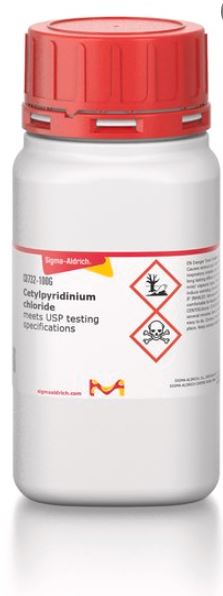CETYLPIRIDINIUM chloride (CPC), powder, 100 g, bot.
Valid Article
CETYLPIRIDINIUM chloride (CPC), powder
Definition
Reagent used for the preservation and decontamination of sputum.
Synonym: Hexadecyl-pyridinium chloride monohydrate
Specifications
Technical specifications
- CAS n°: 6004-24-6
- Formula: C21H38ClN . H2O
- Molecular weight: 358.00 g/mol
- White powder
- Quality: pure
Packaging & Labelling
100 g bottle
Transport Dangerous Goods
- UN 2811
- Class: 6.1
- Packing group: II
- Proper shipping name: Toxic solid, organic, n.o.s. (Cetylpyridinium chloride monohydrate)
Instructions for use
Do not use if the sediment is inoculated on MGIT. Use only when the culture is done on solid media.
Preparation of the solution
- Cetylpyridinium chloride: 1 g
- Sodium chloride: 2 g
- Distilled water: 100 ml
Dissolve the powders with some distilled water (by heating slowly to ease the process).
Do not autoclave, neither filter the solution.
Keep the preparation at room temperature (do not refrigerate). The preparation crystallizes with cold. In case of crystallization, dissolve again the solution by warming up.
Please consult the “Updated laboratory procedures, 2022” available online via the Laboratory working Group sharepoint page: Laboratory Procedures and Resources.
https://msfintl.sharepoint.com/sites/msfintlcommunities/LabWG/SitePages/Laboratory-Manual-page.aspx
For offline access, contact your laboratory advisor.
Storage
- Keep powder and prepared solution at room temperature
- Protected from humidity
- Close the bottle tightly
- Shelf life: 12 months
- Guaranteed minimum remaining shelf life at delivery: 1/3 of total shelf life
Waste management
Substance with hazardous characteristics. Please contact your watsan referent for advice on proper disposal.
Detailed hazard and precautionary information can be found in the safety data sheet (SDS).
Classification EC Regulation N° 1272/2008
- Acute toxicity, Oral: Category 4, H302
- Acute toxicity, Inhalation: Category 2, H330
- Skin irritation: Category 2, H315
- Serious eye damage: Category 1, H318
- Specific target organ toxicity - single exposure: Category 3, H335
- Short term (acute) hazard: Category 1, H400
Signal Word
Danger
| H302 | Harmful if swallowed |
| H315 | Causes skin irritation |
| H318 | Causes serious eye damage. |
| H330 | Fatal if inhaled. |
| H335 | May cause respiratory irritation |
| H400 | Very toxic to aquatic life. |
| P273 | Avoid release to the environment |
| P280 | Wear protective gloves/protective clothing/eye protection/face protection |
| P301 + P312 | IF SWALLOWED: call a POISON CENTER or doctor/physician if you feel |
| P302 + P352 | IF ON SKIN: wash with plenty of soap and water |
| P305 + P351 + P338 | IF IN EYES: rinse cautiously with water for several minutes. If the victim wears contact lenses, remove them if possible. Keep rinsing |
| P304 + P340 + P310 | IF INHALED: Remove person to fresh air and keep comfortable for breathing. Immediately call a POISON CENTER/ doctor. |
MSF requirements
Reagent added to sputum samples during transport to prevent growth of contaminants.


![[ELAESCAE4--] SCALE, electronic (Kern EMB200-2), 0-200g, 0.01g](/web/image/product.template/572458/image_256/%5BELAESCAE4--%5D%20SCALE%2C%20electronic%20%28Kern%20EMB200-2%29%2C%200-200g%2C%200.01g?unique=ef94815)
![[SLASSODC1P1] SODIUM chloride, powder, 1 kg, bag.](/web/image/product.template/571073/image_256/%5BSLASSODC1P1%5D%20SODIUM%20chloride%2C%20powder%2C%201%20kg%2C%20bag.?unique=c032f3e)
![[SLASWATE1B1] WATER, DISTILLED, 1 l, bot.](/web/image/product.template/571056/image_256/%5BSLASWATE1B1%5D%20WATER%2C%20DISTILLED%2C%201%20l%2C%20bot.?unique=4a44107)